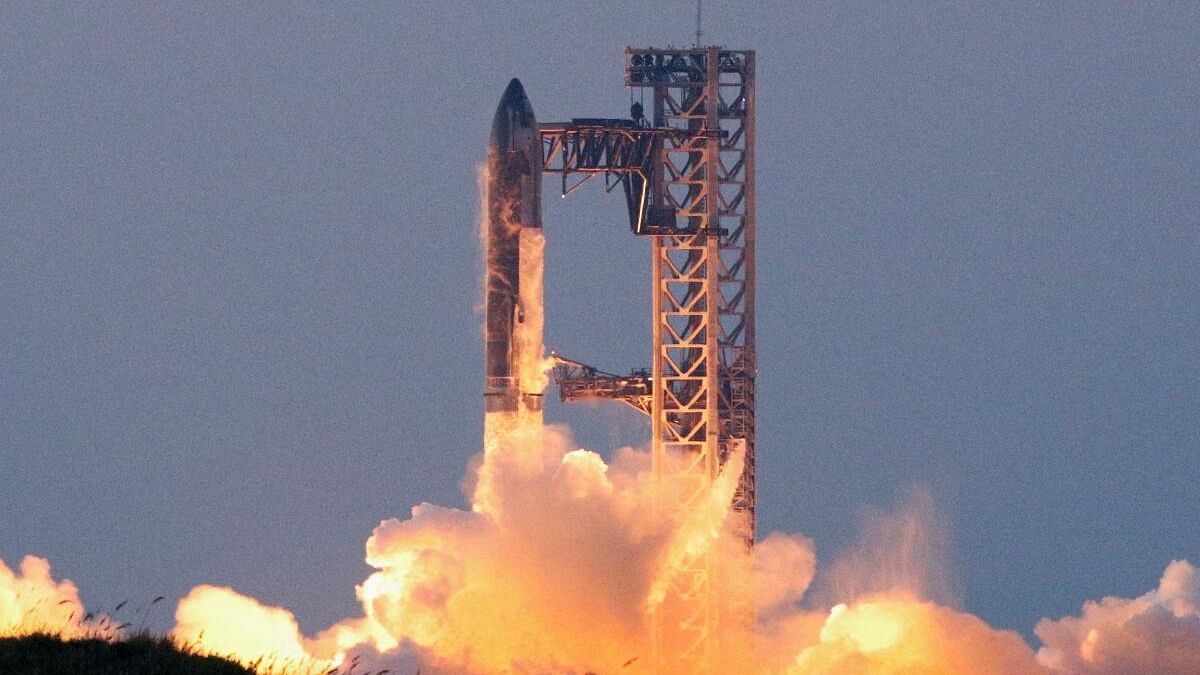
SpaceX's Starship lifts off during its fifth flight test, in Boca Chica, Texas, US, October 13, 2024.
Credit: Reuters Photo
Elon Musk made his early fortune with software companies, and he has adopted that industry's philosophy of not trying to make everything perfect on the first try.
For SpaceX, it is OK to blow up a rocket, as long as the failure provides the data to fix the problems on the next try. That approach can often be faster and save the time and effort of coming up with unnecessary solutions to nonexistent problems.
Each of Starship's four flights has achieved steady progress since the first test launch in April 2023, but they have not been without hiccups.
Flight 1: April 20, 2023
This Starship prototype made it off the launchpad. But, early in the flight, a cascade of engine failures and fires in the booster caused the vehicle to tumble before officials on the ground sent a command to destroy it 24 miles above the Gulf of Mexico.
But even that did not go according to plan -- 40 seconds passed between the self-destruct command being issued and the rocket finally exploding. The launch also hurled debris across a wide area and generated clouds of dust, which reached a small town miles away from the launchpad at the southern tip of Texas.
Musk, the founder of SpaceX, said in an audio chat on social media platform X after the flight that it was "obviously not a complete success, but still nonetheless successful."
Flight 2: Nov. 18, 2023
In November, the second Starship launch traveled much farther, with the upper stage traveling for seven minutes and reaching an altitude of about 90 miles and a speed of about 15,000 mph.
That was itself an achievement because the company completed a step called hot-staging, during which the upper-stage engines ignite before the stage detaches from the lower Super Heavy booster.
According to SpaceX's "fail fast, learn faster" approach toward rocket design, avoiding a repeat of past failures counts as major progress.
Still, both stages of the rocket ended up exploding.
Because the upper spacecraft was empty, extra liquid oxygen was loaded to simulate the weight of a future payload it could carry to orbit. But when the extra oxygen was dumped, a fire started, which set off the flight termination system, destroying the spacecraft.
Earlier in the flight, after the lower and upper stages separated, several of the 33 engines in the Super Heavy booster shut down, and then one blew up, causing the vehicle's destruction over the Gulf of Mexico.
Flight 3: March 4, 2024
The third try turned out to be closer to the charm as the Starship upper stage traveled about halfway around the Earth.
As it coasted in space, the upper Starship stage tested the spacecraft's payload door, and the company demonstrated an ability to move propellant between two tanks inside the vehicle.
But while coasting at the highest point of its trajectory, Starship began rolling out of control. Cameras on board captured the orange glow of hot plasma beneath the spacecraft. Some 49 minutes after launching, it disintegrated.
Earlier in the flight, the Super Heavy booster was to simulate a landing over the Gulf of Mexico. But six of 13 engines used for that maneuver shut down early.
Bill Nelson, administrator of NASA, congratulated SpaceX on what he called a "successful test flight" of the system.
Flight 4: June 6, 2024
The fourth flight accomplished an ambitious set of goals for SpaceX.
After the Super Heavy booster dropped away from the upper stage, the booster was able to gently set down in the Gulf of Mexico. The second-stage spacecraft then traveled halfway around the world, surviving the searing temperatures of reentering the atmosphere while making a controlled splashdown in the Indian Ocean.
The flight was not flawless, and challenging technical hurdles remain. For instance, heat-resistant tiles were lost from the surface of the spacecraft. And, during atmospheric reentry of the upper stage, pieces began peeling away from one of the steering flaps near the top of the spacecraft, though the flap continued to function.
The successes, surpassing what was accomplished during the previous test flight in March, offered optimism for the vision of a rocket that is the biggest and most powerful to date, yet entirely reusable.